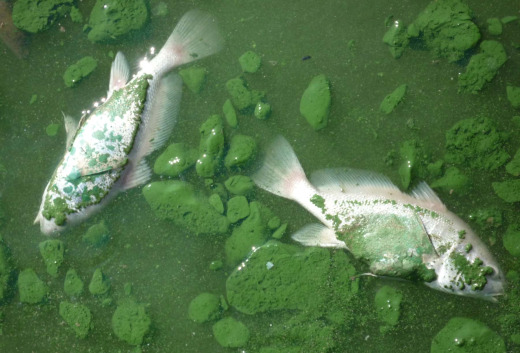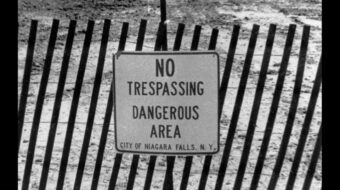
ATHENS, Ohio— While vacationing in the beautiful Hocking Hills region of Ohio we hiked the breath-taking, tree-shaded, ancient gorges cut from Blackhand sandstone. To escape the oppressive 90-degree heat we hoped to take a dip in nearby Lake Hope. But the lake, like 16 other Ohio state park lakes and countless private lakes, was closed because of a toxic blue-green algae bloom.
The algae blooms are a serious environmental and public health crisis, which has grown in the last few decades. Most environmentalists see the situation getting worse because at its root is the state’s multi-billion dollar, agribusiness industry and the rapid growth of factory farming methods.
Nowhere is this more sharply seen than in the closure of the largest inland lake in the state, Grand Lake St. Marys. Situated in the western central part of Ohio, Grand Lake St. Marys has been deteriorating for decades.
The last few years have seen the appearance of new more toxic blue-green algae, which produces a neurotoxin called microcystin and an ugly blue surface scum. Signs warn visitors not to touch the water. In 2009, microcystin were at levels 82 times as high as the standard for safe drinking water.
“The clock is ticking. This lake is dying,” Sean Logan, director of the Ohio Department of Natural Resources (ODNR) told the Dayton Daily News.
“Residents are furious. They are scared and worried about the water supply. Many want to move but they can’t sell their homes,” Virginia Burroughs of Celina told the People’s World. Burroughs, a photojournalist, has been documenting the crisis and dead water fowl.
Burroughs fears a wider public health crisis. Over 100 people have been hospitalized and residents complain of horrible smell, scratchy throats, respiratory problems and raspy voices.
Burroughs has “seen ducks emerge from the water, stagger and then die. The ODNR won’t test them. At some point you say, wait this could be happening to me. It’s a warning. We don’t know the implications.”
Residents recently confronted Republican Minority Speaker Rep. John Boehner, R-Ohio, to demand action. Boehner, whose district encompasses part of the lake, has opposed regulation of factory farms, and is among the top recipients of agribusiness campaign donations.
Boehner also opposes funding for the Environmental Protection Agency. But he said he would get “existing government programs” to come to the aid of the lake, although wouldn’t request any special “earmarks.” (Article continues underneath the slideshow.)
The culprit behind this crisis is the growth of factory or mega farms or CAFOs (confined animal feeding operations) in Ohio in every area of livestock raising. Ohio has some 30 million chickens, making it the second leading egg producing state after Iowa, and is the 7th leading pork producer.
Mercer County, in which part of the lake sits, is the number one agricultural producing county in the state. Forty percent of the state’s CAFOs are in Mercer and Darke Counties.
The 58,000-acre watershed around the lake is home to some 3 million egg producing chickens (or layers) in CAFOs. Some estimate another 3 million layers in non-CAFO farms.
Mercer County also has the largest number of hog farms in Ohio and the second largest number of cattle and calf farms.
According to Ohioans for Humane Farms, factory farms generate more waste in Ohio than humans do and much of its treatment is unregulated. Some factory farms create 100 tons of fecal matter a day. Ninety percent of the manure produced on these factory farms never leaves the area.
In the case of Grand Lake St. Marys, 85% of the excess nutrients from manure and chemical fertilizers that end up in the lake come from factory farm runoff.
Huffington Post blogger David Kirby says the factory farms generate far more animal waste “than the sur round ing land can absorb.” The manure is some times liq ue fied and sprayed from giant sprin klers that spew brownish-yellow water onto crop land, which – too often – runs off into streams and ditches that feed into rivers and lakes, includ ing Grand Lake St. Marys.
The OEPA has approved new sites on watershed lands on the western side of the lake to spread treated human sewage sludge. Add this to the excess phosphorus and nitrogen used to industrially grow the corn and soybeans, plus the pesticides, herbicides and heavy metals, and you have one big mess.
The blue-green algae crisis has hit Lake Erie as well. The huge amounts of farm runoff and rising temperatures are responsible for forms of algae never seen before according to Matt Trokan, Conservation Coordinator of the Ohio Sierra Club.
The Maumee and Sandusky River watersheds lie in the heart of Ohio’s western agricultural lands and empty massive amounts of nutrients into the Great Lake. Algae blooms seen from space are extending near Cleveland and creating a 6,300 square mile dead zone.
“The algae blooms are actually beginning in April now in the farm drainage ditches. Rainstorms wash the water into the creeks and eventually the lakes,” Trokan told the People’s World.
In 2002, authority to regulate factory farms was passed from the Ohio EPA to the Department of Agriculture because the agribusiness industry “sought a more reliably friendly oversight agency,” according to the Dayton Daily News. After a well-funded and deceptive campaign by agribusiness interests, voters passed a ballot measure in 2009, which essentially allows the factory farms to self-regulate by establishing an industry dominated Livestock Care Standards Board.
“Whatever regulations exist are a mere narrative and not enforceable,” said Trokan.
The movement to end the factory farm system continues to grow. It encompasses environmentalists, small farmers, unions, consumers, restaurants and municipalities.
Under threat of passage of a sweeping anti-factory farm election ballot measure in November, an agreement was reached with agribusiness that begins to set standards for some of the factory farm operations. New construction of farms packing egg layers in cages will be barred along with phasing out tight caging of pregnant sows.
However, the same Livestock Care Standards Board dominated by industry appointees will set future standards. It’s only a beginning.
Photo: Dead fish and ducks can be seen floating on top of the polluted Grand Lake St. Mary’s in Ohio. (All photos by Virginia Burroughs/©)

MOST POPULAR TODAY


Zionist organizations leading campaign to stop ceasefire resolutions in D.C. area

Communist Karol Cariola elected president of Chile’s legislature

High Court essentially bans demonstrations, freedom of assembly in Deep South

Afghanistan’s socialist years: The promising future killed off by U.S. imperialism






Comments